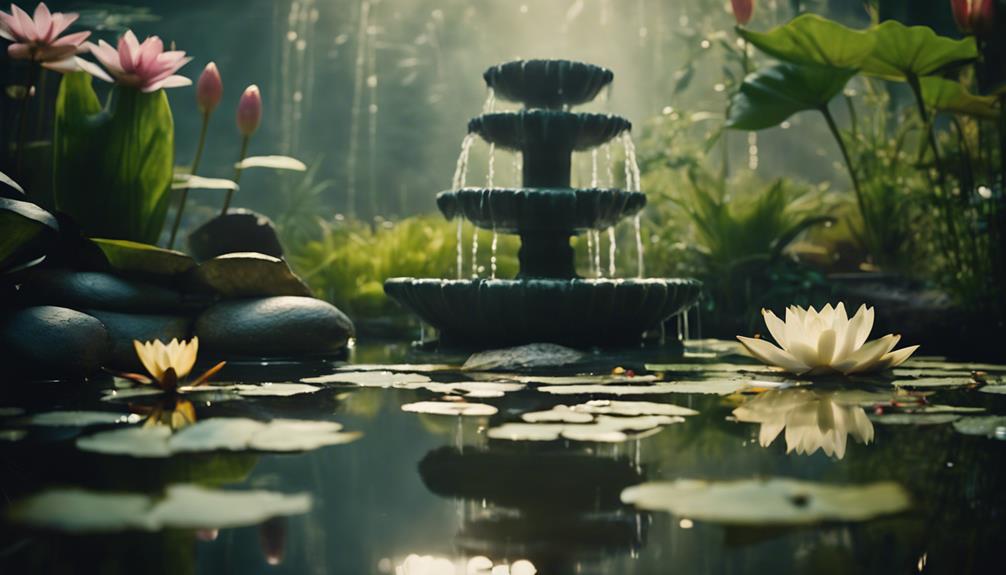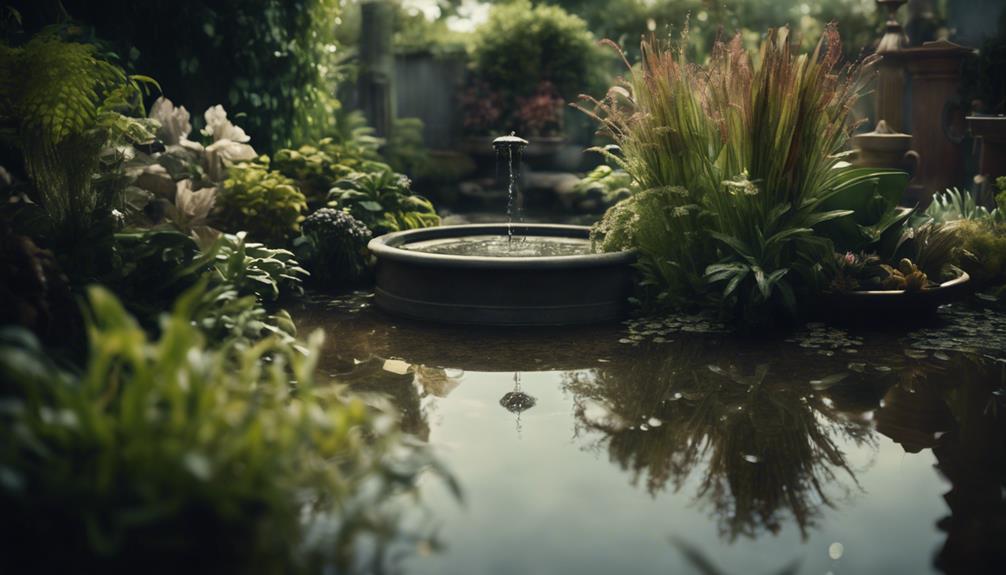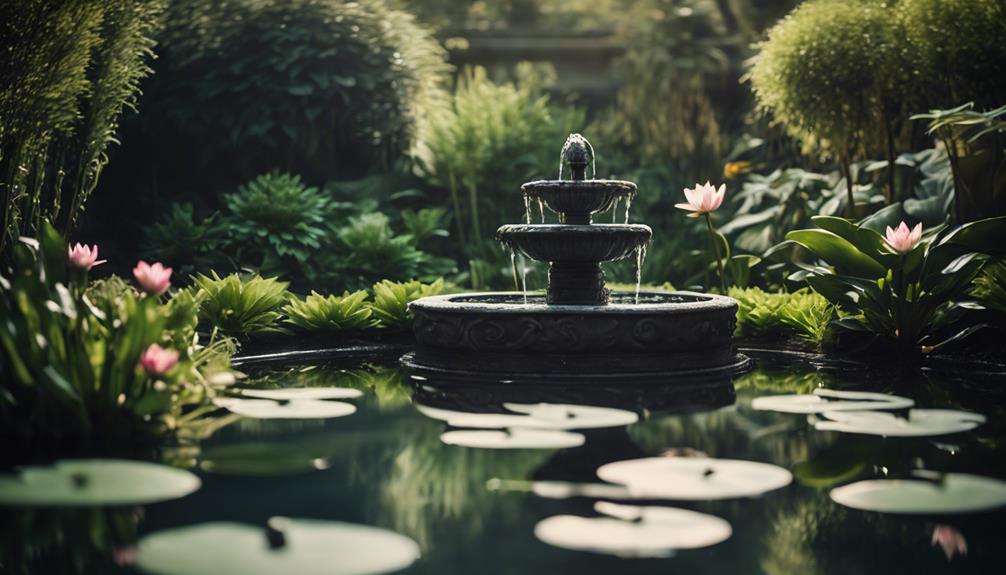When it comes to aerating your small water garden, you'll want to weigh the size and shape of your pond, as well as the type and amount of aeration required. Creating moving water features like fountains or spitters adds oxygen to the water while creating a visually appealing display. Bubbler aerators and diffused aeration systems are also effective options. Regular maintenance is necessary to guarantee peak performance and prevent oxygen starvation. Remember to test and adjust water parameters like pH, ammonia, and nitrite levels to prevent water quality issues. By mastering these basics, you'll be well on your way to creating a thriving ecosystem.
Table of Contents
Key Takeaways
- For small water gardens, use bubbler aerators or fountains to increase oxygen levels and create visually appealing displays.
- Select an aeration system suitable for the pond's size and shape to ensure adequate oxygenation and circulation.
- Regular maintenance is crucial to guarantee peak performance and prevent oxygen starvation in small water gardens.
- Consider eco-friendly alternatives like windmill or solar-powered aeration for remote locations or areas with abundant sunlight.
- Install an aerator or increase water circulation through pumps to add oxygen to the pond and maintain prime water quality.
Understanding Pond Aeration Basics
As you design and maintain your small water garden, understanding the fundamental principles of pond aeration is crucial to creating a thriving ecosystem where fish, beneficial bacteria, and other aquatic life can flourish.
Proper pond aeration is essential for maintaining healthy dissolved oxygen levels, which are critical for the survival of aerobic organisms like fish and beneficial bacteria.
Oxygen enters your pond through direct absorption from the atmosphere and as a by-product of photosynthesis from aquatic plants. However, without proper water movement, oxygen can become stagnant, leading to unhealthy conditions.
Aeration helps distribute oxygen throughout the pond, preventing stagnation and removing excess nutrients that fuel algae growth.
In a well-aerated pond, you'll notice healthier fish, reduced algae growth, and a balanced ecosystem.
Choosing the Right Aeration System
When selecting an aeration system for your small water garden, you'll need to ponder several key factors to guarantee you're getting the right one for your pond's unique needs.
The size of your pond is vital, as you'll want a system that can circulate the entire pond volume at least once every two hours for peak performance.
Think about the type and amount of aeration required, as diffused aeration systems are suitable for larger water bodies, while windmill or solar-powered aeration is ideal for remote locations or areas with abundant sunlight.
Aeration devices like fountains and aerators not only oxygenate the water but also add visual appeal to your pond.
Don't forget to ponder the depth of your pond, as systems like diffused aeration can aerate depths of 25 feet or more.
Aeration Techniques for Small Ponds

You can implement aeration in your small water garden through various techniques that increase oxygen levels, circulation, and overall water quality.
One effective technique is to create moving water features, such as fountains or spitters, which add oxygen to the water while creating a visually appealing display.
Another option is to use bubbler aerators, which release oxygen bubbles into the water, increasing oxygen levels and promoting water clarity.
For a more efficient approach, consider using diffused aeration systems, which distribute air at the pond's bottom, creating a lifting action that circulates and oxygenates the water.
If you're looking for eco-friendly alternatives, windmill aeration and solar-powered aeration are great options, especially for remote locations or areas with abundant sunlight.
Remember to maintain your aeration system regularly to guarantee peak performance and prevent oxygen starvation in your small water garden.
Maintaining Water Quality and Clarity
By regularly testing and adjusting water parameters, such as pH, ammonia, and nitrite levels, you can prevent water quality issues from arising in your small water garden. This proactive approach guarantees a healthy pond environment, where your aquatic plants and fish can thrive.
Adequate aeration plays a vital role in maintaining water quality and clarity. When water is moving, it's more likely to have enough oxygen, which is essential for beneficial bacteria to break down waste and excess nutrients. As a result, you'll notice a significant reduction in algae growth and clearer water.
To add oxygen to your pond, consider installing an aerator or increasing water circulation through the use of pumps or fountains. Regular water changes can also help maintain prime water quality.
Common Aeration Mistakes to Avoid

While maintaining a healthy pond environment is a top priority, it's equally important to recognize common aeration mistakes that can undermine your efforts and harm your small water garden's ecosystem.
One mistake is failing to take into account the size and shape of your pond when selecting an aeration system, leading to inadequate oxygenation and circulation. This can cause a buildup of muck and sludge, promoting algae growth and unhealthy water quality.
Insufficient aeration can also harm aquatic plants and life. On the other hand, over-aerating can disrupt the natural habitat and cause stress to aquatic life.
Additionally, neglecting to regularly maintain and clean your aeration system can reduce its effectiveness and lead to mechanical failure.
To keep your pond thriving, make sure to choose an aeration system that suits your pond's depth and water volume. Regularly inspect and clean your system to guarantee it's working efficiently.
Frequently Asked Questions
What Is the Best Way to Aerate a Small Pond?
When aerating your small pond, you'll want to ponder a pond pump that creates gentle water flow, pairing it with an efficient aeration system that boosts oxygen levels, ensuring a healthy ecosystem and thriving aquatic life.
What Is the Best Method of Aeration in Water Treatment?
Don't you wish you could guarantee your water treatment process is supreme? You're on the right track! Opt for aeration methods that boost oxygen levels through efficient water circulation and adjustable bubble intensity, certifying a healthy and balanced ecosystem.
What Is the Best Way to Aerate Water?
When you want to aerate water, you'll find the best way is to increase oxygen levels through effective aeration methods, such as water circulation and pump selection, which ultimately depend on your specific water treatment needs.
What Is the Cheapest Way to Oxygenate a Pond?
You're on a mission to oxygenate your pond without breaking the bank! Fortunately, you can breathe easy with low-cost options like Pond Pumps ($100-$300), Solar Oxy (50% cost savings), or DIY Bubbles ($20-$50) – all affordable solutions to keep your pond thriving.
Conclusion
With these 5 tips, you'll be breathing new life into your small water garden in no time!
Imagine a pond so healthy, it's like a aquatic oasis, teeming with vibrant life and crystal-clear water that sparkles like diamonds in the sunlight.
By avoiding common mistakes and mastering aeration techniques, you'll create a thriving ecosystem that's the envy of all your friends and neighbors.
So go ahead, take the plunge, and give your pond the oxygen it deserves – your fish (and your neighbors) will thank you!

